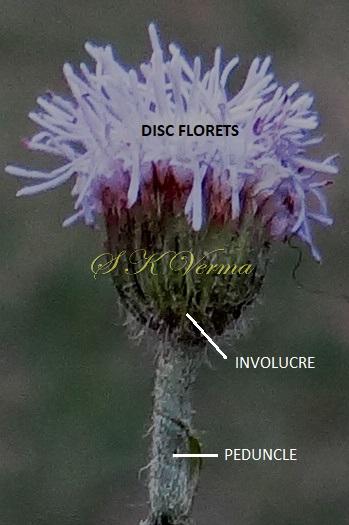AGERATUM
Ageratum
L., Sp. pl. 2: 839. 1753; Gen. Pl. ed. 5: 363. 1754; Hook. f., Fl. Brit. Ind. 3: 243. 1882; Fl. China @ eFloras.org 20-21: 883; Fl. North Amer. @ eFloras.org 21: 481.
Annuals and perennials, mostly 20-120 cm. Stems often decumbent, rooting at proximal nodes. Sparsely to densely branched. Leaves cauline, all or most opposite; petiolate; blades mostly 1-nerved, deltate to ovate or elliptic to lanceolate, margins entire or toothed, faces glabrous or +/- pilose, pubescent, or strigose-hispid, sometimes gland-dotted. Capitula discoid, in dense to open, cymiform to corymbiform or subumbellate arrays. Involucre campanulate, 3-6 mm. Phyllaries persistent, 30-40 in 2-3 series, usually 2-nerved, lanceolate, +/- equal, often indurate, margin scarious. Receptacles conic, epaleate or paleate. Florets 20- 125; corolla white or bluish to lavender, throats +/- campanulate, lobes as long as wide or lengths 2 times diameter; styles: bases not enlarged, glabrous, branched, +/- linear to clavate, usually papillose and dilated distally. Cypselae prismatic, 4-5-ribbed, glabrous or sparsely setuliferous or strigoso-hispidulous; carpopodium distinct, pappi persistent, of 5-6 aristate scales, or coroniform or absent.
38 species
Ageratum conyzoides
Ageratum conyzoides
L., Sp. pl. 2: 839. 1753; Collett, Fl. Siml. ed. 2: 246. 1921 (Reprint 1980); Hook. f., Fl. Brit. Ind., 3: 243. 1882; Dhaliwal & Sharma, Fl. Kullu Dist. 346. 1999; Fl. China @ eFloras.org 20-21: 883; Fl. North Amer. @ eFloras.org 21: 482.
Annual, perennial subshrubs, 20-100+ cm long. Stems robust, usually branched from middle, stems and branches reddish or green towards apex, white puberulent or sparsely to densely tomentose. Leaves opposite; petiole 1-3 cm long, densely white spreading villous; leaf blades ovate to elliptic-oblong, 2-8 cm x 1-5 cm, margin crenate-serrate, both surfaces sparsely to densely pilose and yellow gland-dotted. Capitula small, 6-7 mm across, discoid, in dense terminal corymbs or umbels. Peduncles 0.5-1.5+ cm, powdery puberulent and sparsely to densely pilose, eglandular. Involucre campanulate or hemispheric, 3-3.5 mm x 4-5 mm; phyllaries 2-seriate, narrow, nearly equal, ribbed, oblong or oblong-lanceolate, 3-4 mm x 0.8-1.2 mm, puberulent or sparsely pilose, margin ciliate, tips abruptly tapering. Receptacle conic, epaleate. All florets disc florets, similar, tubular, pale-blue or white. Corolla 1.5-2.5 mm long, glabrous or apically powdery puberulent; tube dilated upwards into throat, tube near equal to throat, throat campanulate, 5-lobed, lobes short. Style base not enlarged, glabrous, style branches long exserted, linear-clavate, glabrous, pale purple. Cypselae (Achenes) black, 5-angled, 1.2-1.7mm long, glabrous. Pappus 1.5-3 mm long, of 5 scales, each with one linear, acute, minutely barbed awn/ seta, scales united at base into a cup-like ring.
Common Names: Goat Weed, Billygoat Weed, Tropical White Weed, Chick Weed, Mentrasto; Jangli Pudina (Hindi)
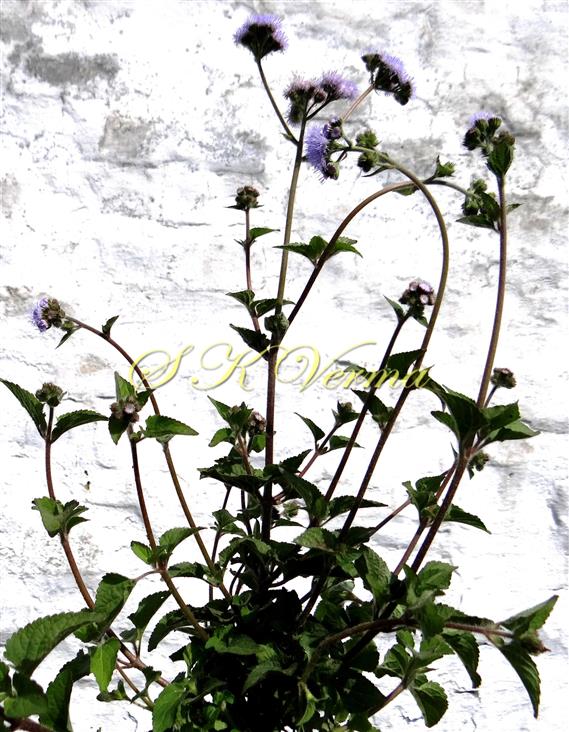
-DSC04324.jpg)
-DSC03884.jpg)
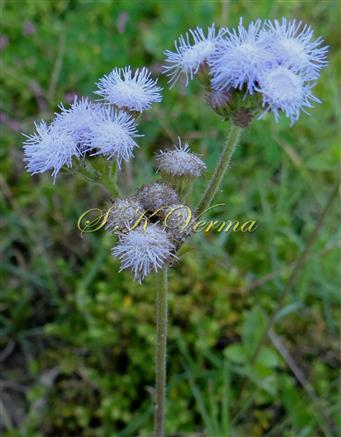
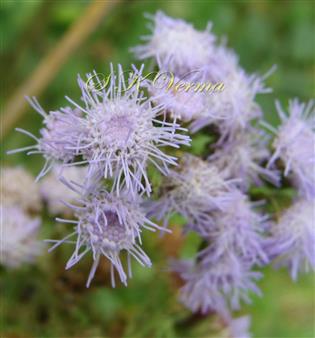

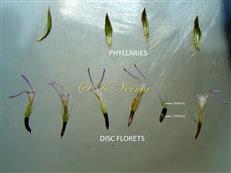



-DSC04324.jpg)
-DSC03884.jpg)


